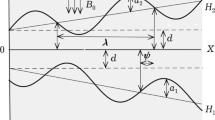Abstract
The propagation of viscous, thin gravity currents of non-Newtonian liquids in horizontal and inclined channels with semicircular and triangular cross-sections is investigated theoretically and experimentally. The liquid rheology is described by a power-law model with flow behaviour index \(n\), and the volume released in the channel is taken to be proportional to \(t^{\alpha }\), where \(t\) is time and \(\alpha \) is a non-negative constant. Some results are generalised to power-law cross-sections. These conditions are representative of environmental flows, such as lava or mud discharges, in a variety of conditions. Theoretical solutions are obtained in self-similar form for horizontal channels, and with the method of characteristics for inclined channels. The position of the current front is found to be a function of the current volume, the liquid rheology, and the channel inclination and geometry. The triangular cross-section is associated with the fastest or slowest propagation rate depending on whether \(\alpha <\alpha _c\) or \(\alpha >\alpha _c\). For horizontal channels, \(\alpha _c=n/(n+1)<1\), whereas for inclined channels, \(\alpha _c=1\), irrespective of the value of \(n\). Experiments were conducted with Newtonian and power-law liquids by independently measuring the rheological parameters and releasing currents with constant volume (\(\alpha =0\)) or constant volume flux (\(\alpha =1\)) in right triangular and semicircular channels. The experimental results validate the model for horizontal channels and inclined channels with \(\alpha =0\). For tests in inclined channels with \(\alpha =1\), the propagation rate of the current front tended to lower values than predicted, and different flow regimes were observed, i.e., uniform flow with normal depth or instabilities resembling roll waves at an early stage of development. The theoretical solution accurately describes current propagation with time before the transition to longer roll waves. An uncertainty analysis reveals that the rheological parameters are the main source of uncertainty in the experiments and that the model is most sensitive to their variation. This behaviour supports the use of carefully designed laboratory experiments as rheometric tests.










Similar content being viewed by others
References
Simpson JE (1982) Gravity currents in the laboratory, atmosphere, and ocean. Ann Rev Fluid Mech 14:213–234
Huppert HE (1986) The intrusion of fluid mechanics into geology. J Fluid Mech 173:557–598
Ungarish M (2010) An introduction to gravity currents and intrusions. CRC Press, Boca Raton
Huppert HE (1982) The propagation of two-dimensional and axisymmetric viscous gravity currents over a rigid horizontal surface. J Fluid Mech 121:43–58
Didden N, Maxworthy T (1982) The viscous spreading of plane and axisymmetric gravity currents. J Fluid Mech 121:27–42
Pinkerton H, Sparks RSJ (1978) Field measurements of the rheology of lava. Nature 276:383–385
Takagi D, Huppert HE (2010) Initial advance of long lava flows in open channels. J Volcanol Geotherm Res 195:121–126
Ugarelli R, Di Federico V (2007) Transition from supercritical to subcritical regime in free surface flow of yield stress fluids. Geophys Res Lett 34:L21402
Sonder I, Zimanowski B, Buttner R (2006) Non-Newtonian viscosity of basaltic magma. Geophys Res Lett 33:L02303
Ng C-O, Mei CG (2004) Roll waves on a shallow layer of mud modelled as a power-law fluid. J Fluid Mech 263:151–183
Burger J, Haldenwang R, Alderman N (2010) Friction factor—Reynolds number relationship for laminar flow of non-Newtonian fluids in open channels of different cross-sectional shapes. Chem Eng Sci 85:3549–3556
Pascal JP (1991) Gravity flow of a non-Newtonian fluid sheet on an inclined plane. Int J Eng Sci 29(10):1307–1313
Gratton J, Minotti F, Mahajan SM (1999) Theory of creeping gravity currents of a non-Newtonian liquid. Phys Rev E 60(6):6960–6967
Di Federico V, Malavasi S, Cintoli S (2006) Viscous spreading of non-Newtonian gravity currents on a plane. Meccanica 41:207–217
Chowdhury MR, Testik FY (2012) Viscous propagation of two-dimensional non-Newtonian gravity currents. Fluid Dyn Res 44:045502
Sayag R, Worster MG (2013) Axisymmetric gravity currents of power-law fluids over a rigid horizontal surface. J Fluid Mech 716(R5):1–11
Longo S, Di Federico V, Archetti R, Chiapponi L, Ciriello V, Ungarish M (2013) On the axisymmetric spreading of non-Newtonian power-law gravity currents of time-dependent volume: an experimental and theoretical investigation focused on the inference of rheological parameters. J Non-Newton Fluid Mech 201:69–79
Piau MP, Debiane K (2005) Consistometers rheometry of power-law viscous fluids. J Non-Newton Fluid Mech 127:213–224
Jacobson MR, Testik FY (2014) Turbulent entrainment into fluid mud gravity currents. Fluid Mech Environ. doi:10.1007/s10652-014-9344-5
Takagi D, Huppert HE (2007) The effect of confining boundaries on viscous gravity currents. J Fluid Mech 577:495–505
Takagi D, Huppert HE (2008) Viscous gravity currents inside confining channels and fractures. Phys Fluids 20:023104
Mei CC, Yuhi M (2001) Slow flow of a Bingham fluid in a shallow channel of finite width. J Fluid Mech 431:135–159
Huppert HE (1982) Flow and instability of a viscous current down a slope. Nature 300:427–429
Muzychka YS, Edge J (2008) Laminar non-Newtonian fluid flow in noncircular ducts and microchannels. J Fluid Eng—ASME 130:111201–111207
Julien PY, Hartley DM (1986) Formation of roll waves in laminar sheet flow. J Hydraul Res 24:1–17
Longo S (2011) Roll waves on a shallow layer of a dilatant fluid. Eur J Mech B 30:57–67
Yang C, Li D (1998) Analysis of electrokinetic effects on the liquid flow in rectangular microchannels. Colloid Surf A 143:339–353
Acknowledgments
Support from Università di Bologna RFO (Ricerca Fondamentale Orientata) 2011 and 2012 is gratefully acknowledged.
Author information
Authors and Affiliations
Corresponding author
Rights and permissions
About this article
Cite this article
Longo, S., Di Federico, V. & Chiapponi, L. Non-Newtonian power-law gravity currents propagating in confining boundaries. Environ Fluid Mech 15, 515–535 (2015). https://doi.org/10.1007/s10652-014-9369-9
Received:
Accepted:
Published:
Issue Date:
DOI: https://doi.org/10.1007/s10652-014-9369-9




